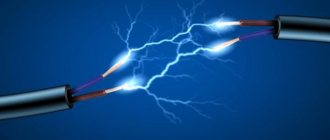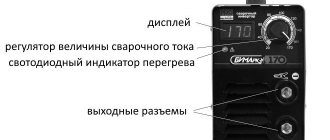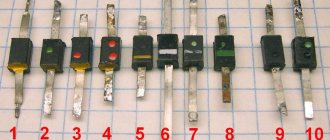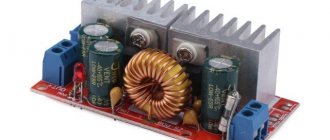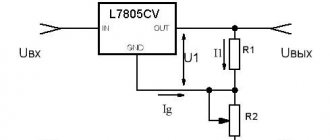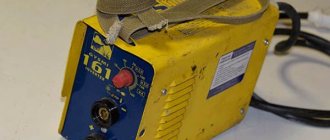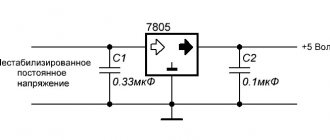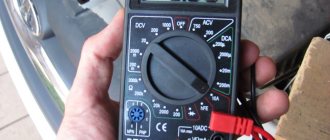We can recall many cases when a converter from 12 volts DC to 220 volts AC would be useful - for example, when you arrive at your dacha by car, you can turn on the lights in the evening or power a watering pump from a battery.
Also, such an inverter is an integral part of wind generators. Buying a ready-made device will not be a problem - and in auto stores you can find car inverters (pulse voltage converters) of various powers and prices.
However, the price of such a medium-power device (300-500 W) is several thousand rubles, and the reliability of many Chinese inverters is quite controversial. Making a simple converter with your own hands is not only a way to significantly save money, but also an opportunity to improve your knowledge in electronics. In case of failure, repairing a homemade circuit will be much easier.
How to make it yourself
If you know how to work with a soldering iron and have basic knowledge of electrical engineering and know how electronic devices work, you can make a voltage converter with your own hands.
Depending on the availability of radio components and the possibility of purchasing them, the circuits of the assembled inverter may be different. The easiest way to make a rectifier is based on a TLT494 PWM controller (the diagram is shown below):
With this configuration, the device, after assembly, will have the following technical characteristics: power - up to 0.3 kW, output signal - modified sine wave, output voltage - 220 V, frequency slightly higher than 50.0 Hz.
Using a pulse generator, which can be the KR1211EU1 microcircuit, you can also assemble a voltage converter. A similar diagram is shown below:
The power of an inverter assembled according to this scheme can reach 0.4 kW.
A 12/220 V converter with transistors is another option for making such a device yourself. A variant of the circuit, when using transistors, is shown in the following figure:
This circuit uses IRFZ44 transistors, which, if necessary, can be replaced with IRFZ40/46/48 or IRF3205/IRL3705, and TIP41 (KT819) transistors, which can also be replaced, if necessary, with KT805, KT815, KT817 and the like.
The assembled circuit (device) has the following characteristics: power - up to 0.3 kW, input voltage - 3.5-18 V, output voltage - 220 V, frequency 57 Hz, output pulse shape - rectangular.
The advantages of this scheme are: simplicity and the ability to assemble even for a person with basic knowledge and skills, low cost of components, compact dimensions of the circuit board and the device as a whole, the ability to replace components.
The disadvantages are: the circuit does not provide protection against short circuit currents, the efficiency is lower than that of factory-assembled products, and the transformer is noisy during operation.
Inverter fault detection
The listed simple circuits have the two most common faults - either there is no voltage at the transformer output, or it is too low.
- The first case is either a simultaneous failure of both arms of the converter, which is unlikely, or a failure of the PWM generator. To check, use an LED probe, which can be purchased at any radio parts store. If PWM is working, you will see the presence of a signal at the gates of the transistors by the rapid pulsations of the diode glow (this is especially noticeable in low-frequency circuits). If there is a control signal, check for breaks in the connections of the transformer and the integrity of its winding.
- A large voltage drop is a clear sign of failure of one of the inverter's power arms. You can find a failed transistor in the simplest way - its radiator will remain cold. Replacing the key will restore the inverter's functionality.
Filter elements
After the rectifier there is a filter. Its main purpose is to cut off the entire alternating component of the rectified current. For a clearer picture, you need to draw up a substitution diagram. So the plus goes through the coil. And then an electrolytic capacitor is connected between plus and minus. This is what is interesting about the replacement scheme. If the coil is replaced by reactance, then the capacitor, in the presence of varying current, can be either a conductor or a discontinuity.
As was said, the output of the rectifier is direct current. And when it is applied to an electrolytic capacitor, nothing happens, since the latter is an open circuit. But there is a small variable in the current. And if alternating current flows, then in the equivalent circuit the capacitor becomes a conductor. Consequently, there is a short circuit between plus and minus. These conclusions were made according to Kirchhoff’s laws, which are fundamental in electrical engineering.
Detailed analysis
The circuit contains a stabilizer that powers the A1 chip. It consists of a chain: R3-VD1-C3, while any similar device with a stabilization indicator of 8-10 volts can be used as a zener diode (VD1).
Please note that capacitors C4 and C5 are installed in parallel. If you do not find them with the same capacity as shown in the diagram, then you can replace them with similar ones (preferably imported) with a capacity of 4700 uF
Capacitor C6 is an element that suppresses high-frequency pulses at the output. It is best to use the K 73-17 brand of domestic production or a similar foreign one for this purpose.
And one last recommendation or nuance. Since a 12-volt network with a consumption of 400 W will generate a current of 40 A, it will be necessary to calculate the cross-section of the wires used. This is especially true for the cable connecting the battery and the converter. Please note that the wire length should be kept to a minimum.
As you can see, making a converter from 12 volts to 220V with your own hands is not very difficult. The circuit is simple, it minimizes the number of parts, which reduces the cost of the device as a whole. Plus its work is more efficient.
Transformer: we’ll select it or do it ourselves
To assemble the inverter, we only need one circuit element that transforms low voltage into high voltage. You can use transformers from power supplies of personal computers and old UPSs; their windings are designed to transform 12/24–250 V and vice versa; all that remains is to correctly determine the conclusions.
Still, it’s better to wind the transformer with your own hands, since ferrite rings make it possible to do it yourself and with any parameters. Ferrite has excellent electromagnetic conductivity, which means that transformation losses will be minimal even if the wire is wound manually and not tightly. In addition, you can easily calculate the required number of turns and wire thickness using calculators available on the Internet.
Before winding, the core ring needs to be prepared - remove the sharp edges with a file and wrap tightly with an insulator - fiberglass impregnated with epoxy glue. Next comes the winding of the primary winding from thick copper wire of the calculated cross-section. After dialing the required number of turns, they must be evenly distributed over the surface of the ring at equal intervals. The winding terminals are connected according to the diagram and insulated with heat shrink.
The primary winding is covered with two layers of Mylar insulating tape, then a high-voltage secondary winding and another layer of insulation are wound. An important point is that the secondary must be wound in the opposite direction, otherwise the transformer will not work. Finally, a semiconductor thermal fuse must be soldered into the gap to one of the taps, the current and response temperature of which are determined by the parameters of the secondary winding wire (the fuse body must be tightly wound to the transformer). The transformer is wrapped on top with two layers of vinyl insulation without an adhesive base, the end is secured with a tie or cyanoacrylate glue.
Useful properties of the devices
Often, inverters from 12 V to 220 V provide protection or weakening of the functioning of information systems from the quality of AC networks. If there is a sudden power outage, using a spare battery and rectifier will restore backup power and you can shut down your computer without losing essential data.
In complex and critical structures, these devices operate in a longer and more controlled mode. This work is carried out both separately and in parallel with the main electrical network. In addition, the inverter can work as an intermediate link in a converter complex.
A distinctive feature in this case is the presence of a high voltage frequency - up to 100 kHz. For efficient operation, semiconductor switches, magnetic materials and special controllers are additionally used. To be convenient for use, the inverter must have high efficiency, reliability and compact dimensions.
Self-production of the device
If for some reason it is not possible to purchase a 12V to 220V voltage converter, then it is easy to make an inverter with your own hands at home. First of all, this applies to analog devices, radio components for which can be taken from old equipment. In addition, with self-assembly, you will be able to understand the nuances of construction, which can be useful for repairing devices of this type.
Simple and reliable inverter
There are a large number of different converter circuits. Their operation is based on the use of a master oscillator that controls the operation of transistor switches. And they, in turn, transmit a pulse signal to a transformer, whose task is to convert the signal to a level of 220 volts. The use of powerful field-effect transistors (mosfets) as switches greatly simplifies the circuit design of devices.
IRL2505 mosfets are connected to the outputs of the microcircuit, direct and inverse. The IRL2505's open channel resistance is only 0.008 ohms. This makes it possible not to use radiators at the required power of up to 100 W.
The generation frequency of the microcircuit is set by the R1-C1 chain and is calculated by the formula: f=70000/(R1*C1). The R2-C2 chain is designed to smoothly start the generator. A 78L08 is used as a linear stabilizer for DA2, with a stabilization voltage of +8 volts. Resistors are used with a power of 0.25 watts. Capacitor C1 is of a film type, and C6 is of any type, but designed for a rated voltage of at least 400 volts. The transformer is used with windings designed for 220 and 12 volts.
Transistor circuit
A generator operating at a frequency of 57 Hz is used as the basis for the manufacture of the structure. The master oscillator controls the operation of power switches, made of powerful field-effect transistors. These transistors can be replaced with IRFZ40, IRF3205, IRF3808, and bipolar ones with KT815/817/819/805.
The power of the inverter depends on the number of complementary field pairs at the output and the characteristics of the transformer. The output voltage is 220–260 volts. When using two pairs of transistors, the power reaches 300 watts. Such a converter does not require adjustment and, with proper assembly and serviceable radio components, works immediately. When operating without load, current consumption is up to 300 mA. For reliable operation, transistors are installed on the heat sink through insulating gaskets. Power tracks, in case of wiring on a printed circuit board, are made with a width of at least 5 mm or with a wire with a cross-section of 0.75 mm2.
The essence of the device’s operation is to convert direct voltage into alternating voltage, after which the signal is supplied to a step-up transformer. The primary winding of a step-up transformer from 12 to 220 volts has fewer turns than the secondary. When current flows in the primary winding, under the influence of an alternating magnetic field, an electromotive force (EMF) appears on the secondary winding. When a load is connected to the secondary winding, alternating current begins to flow through it. To calculate the transformer, you can use reference books or online calculators, but it’s easier to take a ready-made one from an unnecessary uninterruptible power supply.
Powerful boost device
Such converters are manufactured using complex circuits and are difficult to replicate even for experienced radio amateurs. For example, a 12 V 220 by 3000 W inverter circuit:
It is almost impossible to carry out such a scheme with your own hands, since it will be necessary not only to correctly calculate the transformers, but also to correctly configure the master oscillator. And such operations are difficult to perform without special equipment.
The generator is made on the TL081 chip. It is powered by a nine-volt stabilizer. The signal in the microcircuit is converted, reduced in frequency and supplied to power switches. The circuit implements output overload protection, and the input is protected by an overvoltage fuse.
Originally posted 2018-04-18 12:30:34.
What will be the output
In order to reduce the weight and size of the device, with rare exceptions (see below), voltage converters operate at increased frequencies from hundreds of Hz to units and tens of kHz. No consumer will accept a current of such frequency, and the loss of its energy in conventional wiring will be enormous. Therefore, inverters 12-200 are built for the following output voltage. types:
- Constant rectified 220 V (220V AC). Suitable for powering telephone chargers, most power supplies (PS) for tablets, incandescent lamps, fluorescent housekeepers and LED lamps. With a power of 150-250 W, they are perfect for hand-held power tools: the DC power they consume is slightly reduced, and the torque increases. Not suitable for switching power supplies (UPS) of TVs, computers, laptops, microwave ovens, etc. with a power of more than 40-50 W: these necessarily have the so-called. a starting unit, for the normal operation of which the mains voltage must periodically pass through zero. Unsuitable and dangerous for devices with power transformers on iron and AC electric motors: stationary power tools, refrigerators, air conditioners, most Hi-Fi audio, food processors, some vacuum cleaners, coffee makers, coffee grinders and microwave ovens (for the latter - due to the presence of a rotation motor table).
- Modified sine wave (see below) - suitable for any consumers, except for Hi-Fi audio with a UPS, other devices with a UPS from 40-50 W (see above) and, often local security systems, home weather stations, etc. with sensitive analog sensors.
- Pure sinusoidal - suitable without restrictions, except for power, for any electricity consumers.
Sine or pseudosine?
In order to increase efficiency, voltage conversion is carried out not only at higher frequencies, but also with heteropolar pulses. However, it is impossible to power very many consumer devices with a sequence of multi-polar rectangular pulses (the so-called meander): large surges at the meander fronts with even a slightly reactive load will lead to large energy losses and can cause a malfunction of the consumer. However, it is also impossible to design the converter for sinusodal current - the efficiency will not exceed approx. 0.6.
Convert DC voltage to modified and pure sine wave
A quiet, but significant revolution in this industry occurred when microcircuits were developed specifically for voltage inverters, forming the so-called. a modified sinusoid (on the left in the figure), although it would be more correct to call it pseudo-, meta-, quasi-, etc. sinusoid. The current shape of the modified sinusoid is stepped, and the pulse fronts are prolonged (the meander fronts are often not visible at all on the screen of a cathode-ray oscilloscope). Thanks to this, consumers with transformers on iron or noticeable reactivity (asynchronous electric motors) “understand” the pseudosine wave “as real” and work as if nothing had happened; Hi-Fi audio with a network transformer on hardware can be powered with a modified sine wave. In addition, a modified sinusoid can be smoothed out in fairly simple ways to an “almost real” one, the differences from a pure one on an oscilloscope are barely noticeable by eye; Converters of the “Pure Sine” type are not much more expensive than conventional ones, on the right in Fig.
However, it is not advisable to run devices with capricious analog components and UPS from a modified sine wave. The latter are extremely undesirable. The fact is that the middle platform of the modified sinusoid is not a pure zero voltage. The UPS starting unit from a modified sine wave does not operate clearly and the entire UPS may not exit the startup mode into operating mode. The user sees this at first as ugly glitches, and then smoke comes out of the device, as in the joke. Therefore, the devices in the UPS must be powered from Pure Sine type inverters.
Voltage converter from 12 to 220 V for a car
Automotive inverters are low-power devices (up to 0.1 kW), with an output signal in the form of a modified sine wave, activated by plugging into the car's cigarette lighter.
Currently, the following models are popular in this group of products:
"ORION PN-70" (Russia).
Device power – 0.9 kW, output signal – modified sine wave, output voltage 220 V, frequency 50 Hz. Provides short circuit protection. The device is equipped with one plug connector (socket) and a USB port.
"AIRLINE API-150-01" (Russia).
The output power of the device is 0.15 kW, the output signal is a modified sine wave. The device is plugged directly into the car's cigarette lighter and is equipped with one plug connector for a voltage of 220 V. The model is equipped with a USB port, its weight is 400.0 grams.
"AIRLINE API-200-02" (Russia).
This model is connected to the cigarette lighter using connecting wires. Device power – 0.2 kW. This model has protection against short circuit currents, one USB port and one socket for a voltage of 220.0 V.
"WESTER MSW250" (Germany).
Power – 0.25 kW, the model is equipped with a short-circuit current protection device, a USB port and a socket for a voltage of 220.0 V. The output signal is a modified sine wave.
"MYSTERY MAC-1000" (China).
Device power – 1.0 kW, number of sockets for 220 V voltage – 2 pcs., USB port.
The weight of the model is 2.6 kg.
TOP 3 - the best converter models and their technical characteristics
The rating is based on popularity and is a selection of the best, according to experts, car inverters of 2020.
AVS IN-2000W
Car inverter 12 V 220 high power up to 2 kilowatts. Available in an aluminum housing to aid heat dissipation. There is a built-in cooling cooler. The body has convenient mounting holes, through which it can be attached to the wall of a truck or minibus. Capable of delivering current up to 10 Amps.
Advantages of AVS IN:
- USB connector, which allows you to integrate charging for a cell phone or navigator without an additional adapter;
- powerful built-in short circuit protection;
- long and reliable operation - up to 5 years of continuous operation;
- convenient power key.
Minuses:
- high cost - 7 thousand rubles or more;
- too short wires for connecting through the battery terminals;
- inability to integrate with the cigarette lighter;
- heavy weight - more than 2 kilograms;
- There is only 1 socket for connection, so you need a separate tee to power several devices.
ROBITON R200
150 Watt inverter designed to convert DC to AC. It is possible to connect a laptop, chargers, and various electrical tools. There is a convenient USB connector for additional capabilities. Made using advanced technologies, it has a multi-level protection system:
- short circuit;
- overheat;
- overload;
- polarity reversal;
- insufficient input voltage.
The 12 to 220 converter has an F type power socket - the contacts are grounded. During overheating it automatically turns off. Availability of a built-in fan.
WESTER MSW250 12-220V+USB
In terms of the ratio of output power and ease of use, the inverter from the manufacturer Wester is called the best among its analogues. It produces a stable voltage of 250 Watts, the peak load can reach up to 500 Watts. Easily integrates with the cigarette lighter - no need to stop on the road to connect the adapter to the battery terminals.
Here are the advantages of this converter noted by experts:
- the presence of an LED indication that allows you to monitor the operation of the device, overheating, and sleep mode;
- relatively low cost - from 1,700 rubles;
- the presence of a separate USB connector, integrated with the camera and phones;
- a high-quality, dense European socket in which plugs from various household appliances do not fall out even from strong vibrations on the roads;
- the ability to connect to a cigarette lighter, which eliminates accidental polarity reversal and protects the rectifier from burnout;
- system of automatic recognition of low and too high voltage, self-shutdown;
- presence of a separate fuse;
- short circuit protection;
- light weight.
There are also disadvantages:
- does not integrate with 2 A laptops;
- The cooler makes a loud noise while cooling.
Low Voltage Shutdown
If you use a battery in your design that operates in parallel in a car, then it is recommended to ensure that the converter from 12 to 220 is automatically turned off when the charge is low. It is not difficult to assemble a simple shutdown circuit with your own hands. If the battery is completely discharged, you will not be able to start the engine even from a tow. Therefore, introduce a simple element into the circuit - an electromagnetic relay. These are used in cars, so finding one will not be difficult.
The relay has a lower voltage threshold at which the contacts close. To adjust the torque more accurately, it is necessary to select the resistance of resistor R1. It should be equal to the resistance of the relay winding multiplied by a factor of 0.1. You can implement such a modification without much difficulty in a converter from 12 to 220. Even a novice electrician can connect the relay and resistor with his own hands.
But such a scheme is primitive, and its efficiency is extremely low; it is better to use a modernized one; it maintains more precisely the threshold for disconnecting the battery from the inverter.
Areas of application
Inverters are used in various situations:
- On long trips, they provide the ability to connect the necessary devices (refrigerator, electrical tools, etc.) to the car battery.
- Conversion of energy obtained from alternative sources (for example, from solar panels).
- Backup power supply to your home in case of an unexpected power outage.
- Source of energy in suburban areas in the absence of centralized electrification, etc.
To perform each of these tasks, select the appropriate converter models. Most often, 12/220 inverters are used by motorists.
Devices with 12 V and 24 V input voltages are not interchangeable!
Battery and power
The suitability of the converter for a particular purpose also depends on the battery. A boost voltage inverter does not take energy for consumers from the “dark matter” of the Universe, black holes, the holy spirit, or anywhere else just like that. Only from the battery. And from it he will take the power supplied to consumers, divided by the efficiency of the converter itself.
Car enthusiasts know: if you run the starter for 20 minutes, buy a new battery. True, new machines have time limiters for its operation, so perhaps they don’t know. And certainly not everyone knows that the starter of a car, once spun up, takes a current of approx. 75 A (within 0.1-0.2 s at startup - up to 600 A). The simplest calculation - and it turns out that if the inverter does not have automatic equipment that limits the battery discharge, then ours will run out completely in 15 minutes. So choose or design your converter taking into account the capabilities of the existing battery.
The service life of acid batteries does not noticeably decrease if they are discharged with a 2-hour current (12 A for 60 A/h, 24 A for 120 A/h and 42 A for 210 A/h). Taking into account the conversion efficiency, this gives a permissible long-term load power of approx. 120 W, 230 W and 400 W respectively. For 10 min. load (for example, to power a power tool), it can be increased by 2.5 times, but after this the ABC must rest for at least 20 minutes.
Overall, the result is not entirely bad. Of the ordinary household power tools, only the grinder can take 1000-1300 W. The rest, as a rule, cost up to 400 W, and screwdrivers up to 250 W. A refrigerator from a 12 V 60 A/h battery will work through an inverter for 1.5-5 hours; quite enough to take the necessary measures. Therefore, making a 1 kW converter for a 60 A/h battery makes sense.
Classification
The main classification criteria for these devices are power, current shape and input voltage. The choice of a specific model depends on the purposes for which the device is purchased.
To connect to a car cigarette lighter, the simplest compact converters of low power are used. Gadgets with low power consumption (phones, laptops, fans, flashlights) can be powered from them.
The power of the inverter connected to the cigarette lighter should not exceed 150 W. Otherwise, you can damage the entire electrical wiring of the car.
Converters for powering devices with a power of 150 W or more are connected directly to the battery terminals. To reduce efficiency losses, it is not recommended to use “crocodiles”, which are included in some models. For a stable and reliable connection, copper terminals with a screw connection are more suitable.
Rated and peak power
When choosing a converter, you should sum up the power of all consumers that will be connected to it. Another 20% is added to the result obtained, since the device will not be able to operate at its maximum capabilities for a long time. In addition, losses are possible due to poor contact in connections or poor cable quality. You also need to consider the battery capacity.
It is necessary to calculate the power of the inverter according to two characteristics: nominal and peak. The first of them determines the load under which the device can operate for a long time. For household models, it usually ranges from 60 to 1000 W. However, there are modifications in which this figure exceeds 1 kW. With their help, you can set up a mobile mini-power station. It is advisable to buy them, for example, to connect power tools.
Peak power characterizes the maximum load that the inverter can withstand for a short period of time. It varies between 150 - 10000 W. The current consumed by some electrical appliances when starting up is several times higher than the rated value.
When choosing a converter, you must pay attention to this point, otherwise the equipment connected to it may not start
Expert opinion Kuznetsov Vasily Stepanovich
If the device is used while the car engine is running, its load current should not be higher than the current generated by the generator.
For domestic needs (for example, traveling by car), an inverter with a power of up to 600 W is usually sufficient. This is enough to turn on the refrigerator, charge your phone, laptop or flashlight. The load current of such a device is approximately 50 A, which is significantly less than that of modern automobile generators.
Current form
An important criterion for choosing a converter is the shape of the current obtained at the output. This parameter determines which devices can be connected to it.
There are two types of form:
- Pure (continuous) sine wave. The current diagram is a smooth sinusoid. Such devices ensure safe connection of any equipment. The circuitry of these devices includes expensive components, so the price for them is quite high.
- Modified (changed) sinusoid. The current diagram is stepped. Such inverters cannot be used to connect power tools with asynchronous motors, compressors and devices susceptible to interference. The equipment will either not start at all or will operate in extreme mode, which leads to a decrease in efficiency and a shortened service life. Converters with a modified sine wave are suitable for powering lamps, heaters, brushed motors, telephones, laptops, and televisions. The quality of work can be improved by additionally installing a soft starter.
The cost of pure sine wave inverters is quite high. It is advisable to purchase them only if you need to connect equipment that is incompatible with the modified sine wave.
How to make a 12/220 converter with your own hands
A conventional pulse converter has a very simple circuit. Most of the required parts are soldered from the old power supply. True, the output voltage of 220 Volts will be far from sinusoidal and does not correspond to a frequency of 50 Hz. This means that it will not be possible to connect electronics or instruments directly. But there is a solution: installing a rectifier with smoothing capacitors at the output.
The main part of the circuit in the photo is the TL494 PWM controller. The frequency is set by capacitor C2 and resistor R1. Their denominations may differ from those presented.
The other circuit is old, assembled using domestic elements, but produces a voltage of 220 Volts with a frequency of 50 Hz. The generator here is a dual D-trigger, which is an analogue of the foreign CD4013 microcircuit. If necessary, replacement can be made without changes to the circuit. This circuit has many disadvantages: rapid overheating, the mandatory use of a powerful steel core, non-sinusoidal output, noise during operation.
It is possible to do without an adapter if you need to use a drill or other tools. Instead, a gasoline generator is installed - fed from the engine. This device can even charge a dead battery - a handy thing!
Common Schemes
To convert voltage from one level to another, pulse converters with installed inductive energy storage devices are used. Based on this, three types of conversion schemes are distinguished:
- Inverting.
- Raising.
- Downgrades.
All of the following circuits use electrical components:
- Main switching component.
- Power supply.
- A filter capacitor that is connected in parallel with the load resistance.
- Inductive energy storage (choke, inductor).
- Diode for blocking.
Combining these elements in a certain sequence allows you to build any of the above schemes.
Simple pulse converter
The most basic converter can be assembled from unnecessary parts from an old computer system unit. A significant drawback of this circuit is that the 220V output voltage is far from ideal in its sine wave shape and has a frequency exceeding the standard 50 Hz. It is not recommended to connect sensitive electronics to such a device.
This scheme uses an interesting technical solution. To connect equipment with switching power supplies (for example, a laptop) to the converter, rectifiers with smoothing capacitors are used at the output of the device. The only negative is that the adapter will only work if the polarity of the output voltage of the socket matches the voltage of the rectifier built into the adapter.
For simple energy consumers, the connection can be made directly to the output of transformer TR1. Let's consider the main components of this scheme:
- Resistor R1 and capacitor C2 - set the operating frequency of the converter.
- PWM controller TL494. The basis of the whole scheme.
- Power field effect transistors Q1 and Q2 are used for greater efficiency. Placed on aluminum radiators.
- IRFZ44 transistors can be replaced with IRFZ46 or IRFZ48 with similar characteristics.
- Diodes D1 and D2 can also be replaced with FR107, FR207.
If the circuit involves the use of one common radiator, it is necessary to install transistors through insulating spacers. According to the scheme, the output choke is wound onto a ferrite ring from the choke, which is also removed from the computer power supply. The primary winding is made of 0.6 mm wire. It should have 10 turns with a tap from the middle. A secondary winding consisting of 80 turns is wound on top of it. The output transformer can also be removed from an unnecessary UPS.
The scheme is very simple. When assembled correctly, it starts working immediately and does not require fine tuning. It will be able to supply a current of up to 2.5 A to the load, but the optimal operating mode will be a current of no more than 1.5 A - and this is more than 300 W of power.
INTERESTING: In a store, a similar converter costs around 3-4 thousand rubles.
Converter circuit with AC output
This scheme is also known to radio amateurs of the USSR. However, this does not make it ineffective. On the contrary, it has proven itself very well, and its main advantage is the receipt of stable alternating current with a voltage of 220V and a frequency of 50 Hz.
The K561TM2 microcircuit, which is a dual-type D-trigger, acts as an oscillation generator. This element can be replaced with a foreign analogue CD4013.
The converter itself has two power arms built on KT827A bipolar transistors. They have one significant drawback compared to new field-effect transistors - these components become very hot when open, which is due to high resistance values. The converter operates at low frequency, so a powerful steel core is used in the transformer.
This circuit uses an old TC-180 network transformer. It, like other inverters based on simple PWM circuits, produces a significantly different sinusoidal voltage waveform. However, this drawback is slightly mitigated by the high inductance of the transformer windings and the output capacitor C7.
IMPORTANT: Sometimes the transformer may produce a noticeable hum during operation. This indicates a problem with the circuit.
Purpose and principle of operation
What is a voltage converter. This is the name given to an electronic device that changes the magnitude of the input signal. It can be used as a device to increase or decrease its value. The input voltage after conversion can change both its magnitude and frequency. Such devices that change DC voltage (convert it) into an AC output signal are called inverters.
Voltage converters are used both as a stand-alone device that supplies consumers with alternating current energy, and can be included in other products: uninterruptible power supply systems and supplies, devices for increasing direct voltage to the required value.
Inverters are harmonic voltage generators. Using a special control circuit, a DC source is created to periodically switch polarity. As a result, an alternating voltage signal is generated at the output contacts of the device to which the load is connected. Its magnitude (amplitude) and frequency are determined by the elements of the converter circuit.
The control device (controller) sets the source switching frequency and the shape of the output signal, and its amplitude is determined by the elements of the output stage of the circuit. They are designed for the maximum power consumed by the load on the AC circuit.
The controller is also used to regulate the magnitude of the output signal, which is achieved by controlling the duration of the pulses (increasing or decreasing their width). Information about changes in the value of the output signal at the load enters the controller via a feedback circuit, on the basis of which a control signal is generated in it to save the necessary parameters. This technique is called PWM (pulse width modulation) of signals.
In the circuits of power output switches of a 12V voltage converter, powerful composite bipolar transistors, semiconductor thyristors, and field-effect transistors can be used. Controller circuits are implemented on microcircuits, which are ready-to-use devices with the necessary functions (microcontrollers), specially designed for such converters.
The control circuit ensures the sequence of operation of the keys to provide at the inverter output the signal necessary for the normal operation of consumer devices. In addition, the control circuit must ensure symmetry of the half-waves of the output voltage
This is especially important for circuits that use step-up pulse transformers at the output. For them, the appearance of a constant voltage component, which can appear when symmetry is broken, is unacceptable
There are many options for constructing voltage inverter (IN) circuits, but there are 3 main ones:
- IN transformerless bridge;
- transformer IN with neutral wire;
- bridge circuit with transformer.
Each of them finds application in its own area, depending on the power source used in it and the required output power to power consumers. Each of them must have protection and alarm elements.
Protection against undervoltage and overvoltage of the DC source determines the operating range of the inverters “at the input”. Protection against high and low output alternating voltage is necessary for the normal operation of consumer equipment. The operating range is set according to the requirements of the load used. These types of protection are reversible, that is, when the equipment parameters are restored to normal, operation can be restored.
When protection is triggered due to a short circuit in the load or an excessive increase in output current, a thorough analysis of the causes of this event is necessary before continuing to operate the equipment.
The 12V converter is the most suitable for creating a local power network. The availability of a large number of vehicles and 12V DC batteries allows them to be used to meet user demands. Such networks can be created in a variety of places, starting from your own car. They are mobile and do not depend on the parking location.
Review of the best autoinverters
The following parameters were used to compile the rating:
- power;
- output voltage quality;
- behavior under overloads;
- equipment;
- additional functions (if any);
- reviews in real life and on the Internet;
- appearance;
- average price in March 2016.
MAP "Energy" 900
Power 900 watts, input voltage 10-15 volts. Output voltage with a minimum number of harmonics and a frequency of 50 hertz. When the load exceeds 1.3 kilowatts, it automatically turns off. If the load is normal, then the voltage is stable. Can be used as a powerful starting charger (reverse conversion from 220 to 12 volts). Appearance - a large and heavy box with a digital indicator and switches. Cost 35 thousand rubles.
Calm PS12/300
Power 300 watts, input voltage 10.5–14 volts. Output voltage with a minimum number of harmonics and a frequency of 50-60 hertz. If the output load is less than 300 watts, then the voltage is stable. As the load power increases, the voltage begins to drop. The inverter is equipped with wires and connectors for connecting to a car battery, as well as an adapter for the cigarette lighter. It looks like a gray unsightly box with rubber legs. Cost 4500 rubles.
MobilEn SP-150
The declared power is 150 watts, but in tests it could withstand a load of 180 watts without reducing the voltage. Connecting an additional load triggers the protection. When overloaded, it signals with a slight but unpleasant squeak. After switching off it beeps very loudly. Output voltage with a minimum of harmonics with a frequency of 50-60 Hz. Equipped with a standard USB port, so you can use it to charge your phone, camera, video camera or iPod. Appearance - a small rectangular box, on one end of which there is a standard socket, on the other there is a double wire with an adapter for the cigarette lighter. Cost 1300 rubles.
MeanWell A301‑150‑F3
Power 150 watts, input voltage 10.5–15 volts. Output voltage with a minimum of harmonics and a frequency of 50-55 hertz. When the load increases to 175 watts, automatic shutdown occurs. Equipped with a standard socket and power cord with a cigarette lighter adapter. It looks like a neat silver cylinder. Cost 3500 rubles.
AcmePower DS-120
The declared power is 120 watts, but it works well only with a load of less than 100 watts. When the load power increases to 107-110 watts, the device automatically turns off. Output voltage with an average number of harmonics and a frequency of 50-60 hertz. Equipped with a standard USB port, so you can use it to charge your phone, camera, video camera or iPod. The kit includes a cable with an adapter for the cigarette lighter. Appearance – a neat small flat box made of black/gray plastic. Cost 750 rubles.
